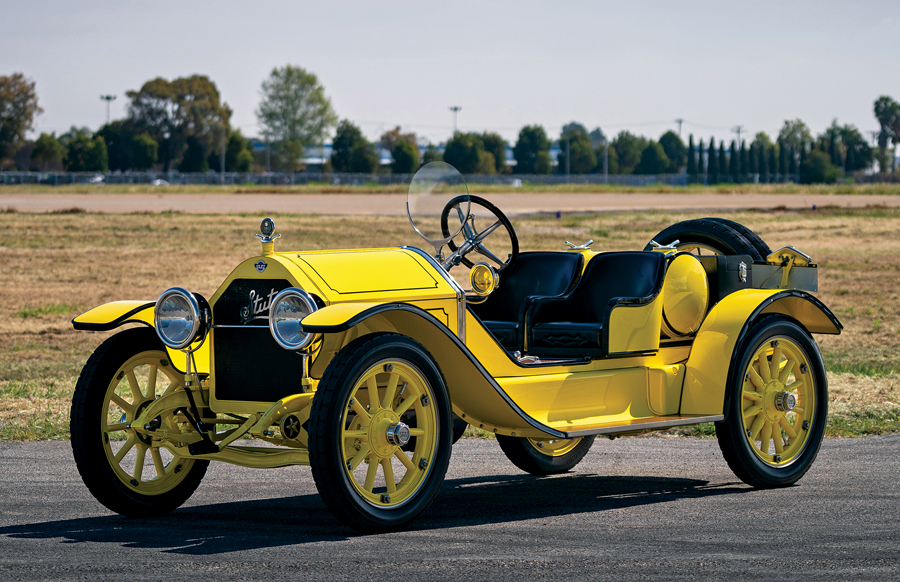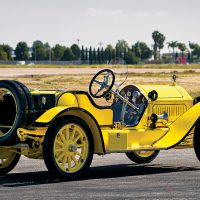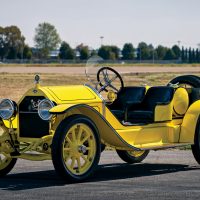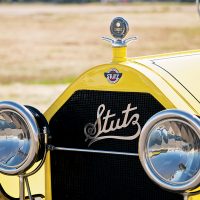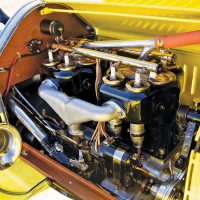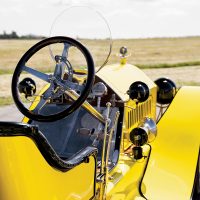- An authentic Bearcat, as noted by the late historian/restorer Paul Freehill
- Well-preserved, award-winning restoration
- Formerly part of the Charles LeMaitre and James Bradley Collections
- Open Best of Show and class winner at 2011 Ironstone Concours
- One of America’s earliest sports cars; a performance icon of its time
SCM Analysis
Detailing
| Vehicle: | 1915 Stutz Model 4F Bearcat |
| Years Produced: | 1912–16 |
| Number Produced: | 1,079 (all Stutz 1915 production) |
| Original List Price: | $2,000 |
| SCM Valuation: | $330,000 (this car) |
| Tune Up Cost: | $500 |
| Chassis Number Location: | Firewall plaque, transaxle |
| Engine Number Location: | Right side above mount |
| Club Info: | The Stutz Club |
| Website: | http://www.stutzclub.org |
| Alternatives: | 1911–14 Mercer Raceabout, 1909–14 Marmon Speedster, 1911–14 National Speedway/Semi-Racing Roadsters |
| Investment Grade: | B |
This car, Lot 405, sold for $330,000, including buyer’s premium, at RM Auctions’ Hershey, PA, auction on October 11, 2019.
Any discussion of American sports cars usually begins with the Stutz Bearcat and its similar-looking rival, the Mercer Raceabout.
The Bearcat (initially called the Bear Cat, then Bear-Cat in inconsistent Stutz factory literature) became the most famous car of its day — after Henry’s Model T, of course.
Author Ralph Stein summed it up, “Come to a halt at a stoplight on an American road in any open, bucket-seated, doorless sporting car of the pre-World War I days, and almost everyone, ancients who you’d think would know better as well as kids who never saw one…will yell, “Hey, mister, that’s a Stutz Bearcat, ain’t it?”
Even into the 1950s and 1960s, the car’s fame was such that two disparate makes of automobiles, Nash and Triumph, proclaimed in ads that their cars were worthy successors to the Bearcat.
In 1951, Tom McCahill told readers the Bearcat’s fame “was as solidly entrenched as the Statue of Liberty or Babe Ruth” among generations of car buffs.
The model even lent its name to a 1970s television action series.
Although it looks like any one of a number of cars of its period, there was something about the Bearcat. Perhaps it was the Harry Stutz story, the car’s racing exploits — or maybe it was just a catchy name that ingrained itself in the national memory.
A legend is born
A taciturn Ohio farm boy from Pennsylvania Dutch stock, Harry C. Stutz found machines more to his liking than farming. After building his first car at 22, he then designed and manufactured industrial stationary engines.
After moving to Indianapolis, he made the rounds of several firms, learning something at each, all the while taking correspondence courses.
A stint as chief engineer, factory and racing manager at Marion convinced him he should build his own car — but not before designing an aluminum transaxle and forming a company to manufacture it. He was just 35.
Believing there was a market for a performance car in the $2,000 range, he selected a 60-hp, 390-ci Wisconsin T-head 4 to power it.
A firm believer in “racing improves the breed” (and its sister credo “Win on Sunday, sell on Monday”), Stutz entered the prototype Bearcat in the inaugural Indianapolis 500, where it finished a respectable 11th.
While just outside the money, Stutz was pleased that no repairs were required during the race. The car’s only problems stemmed from tire issues, which resulted in 13 pit stops. Although it never won the Indy 500 (finishing 4th in 1912, 3rd in ’13, 5th in ’14 and 3rd in 1915), the Stutz’s immaculately uniformed team triumphed at venues across the country, twice taking Earl Cooper to the AAA national championship.
Many of the races were won against expensive imports with larger engines and got a lot of public attention, and the team earned a national following. The racing publicity worked, and the factory was often backlogged with orders. While most Stutz sales were touring cars and coupes, the sporty Bearcat was the star.
Driving an icon
No matter how glorious, history is the stuff of books, so what are Bearcats like to drive? Carl Jensen, a collector/restorer and modern Porsche racer, offered his impressions after getting behind the wheel of a Bearcat this summer at the Milwaukee Mile.
“At first you sense an antiquated suspension as the car leans as you climb in from the passenger side (to avoid the driver’s side gear and brake levers). You hit the starter and a pounding heartthrob lets you know this beast is all business.
“With surprisingly little effort, the transmission slides into gear and pulls away with a surplus of torque. Upshifts are smooth, solid and predictable. The car accelerated far faster than you’d expect from a car of its 3,000-pound weight and 60 hp. What really amazed me is how rock solid the car is. Passing 65 mph on a track, there was not a shake, shimmy or hint of drifting off line.
“The car wasn’t even sweating and it felt there was more power waiting. The first corner you take at speed, the balance of front/rear weight distribution (thanks to its transaxle) is a bit surprising; by the second turn you know what to expect and go even faster. The car feels like it could lap at speed all day. The biggest shortcoming of the car, and standard for its day, are its two-wheel mechanical brakes. Whereas my 1930 Stutz speedster with its four-wheel hydraulics will stand on its nose, the old Bearcat has more go than stop.”
Our yellow Bearcat
Most 100-plus-year-old cars have a backstory, as does this example.
It was reportedly found in 1982 inside a shipping container in the U.K., wearing a 1920s-style body. A Stutz expert/restorer/parts maker confirmed that it had started life as a Bearcat, and it had the correct 118-inch wheelbase and a genuine 1915 fuel tank.
He was then commissioned to build the rest of the body. After returning to the U.S., the car was re-restored, had its engine overhauled, and passed through three collections before the consignor bought it in 2010.
Photos show it to be in spotless and correct condition; the only deviations from stock seem to be limited to the Stutz script on the radiator and the extra spare tire.
Interestingly, the yellow often seen on Bearcats wasn’t listed as a factory color (two reds and gray were). Today, most experts assume the factory would paint a car any color desired. And given its age, no one is likely come up to you at a car show and tell you they didn’t come from the factory like that.
The car makes two prior appearances in the SCM Platinum Auction Database, selling for an identical $330k at a 2010 RM sale (SCM# 166274), a slight drop from the $368,500 it brought at RM’s Meadow Brook sale in 2006 (SCM# 42406).
In both cases, the car was rated in #2 condition and had identical mileage.
Open body (1912–16) Bearcats generally fall in the $250k–$400k range, although special cars like a very early 1912 model have sold for substantially more — such as $770,000 (SCM# 231777). The outlier is the record $1.375 million sale of a well-known, no-stories, two-owner 1914 at Gooding & Company’s 2008 Pebble Beach sale (SCM# 117598).
In a market of $300k resto-mods and depreciating new exotics, $330k for a genuine legend doesn’t seem too bad.
After a century, it still has the power to thrill a new generation of fans. After sampling the Bearcat, Carl Jensen began the restoration of one to park alongside his Porsche. ♦
